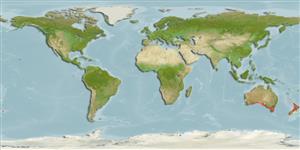Environment: milieu / climate zone / depth range / distribution range
Ecology
Marine; demersal; depth range 20 - 200 m (Ref. 9563). Temperate; 29°S - 47°S, 113°E - 176°W
Indo-West Pacific: New Zealand and Australia (southern Western Australia to New South Wales and Tasmania).
Size / Weight / Age
Maturity: Lm ? range ? - ? cm
Max length : 31.0 cm TL male/unsexed; (Ref. 9563); common length : 25.0 cm TL male/unsexed; (Ref. 9258)
Inhabits rocky weedy areas from the shore to at least 60 m. Generally solitary but may aggregate in groups of 10-15 individuals in midwater. Feeds mainly on sessile and encrusting organisms, with sponges and ascidians predominating (Ref. 26966); also seen feeding mid-water on zooplankton and likes to bite diver's fingers (Ref. 9002).
Life cycle and mating behavior
Maturity | Reproduction | Spawning | Eggs | Fecundity | Larvae
Armitage, R.O., D.A. Payne, G.J. Lockley, H.M. Currie, R.L. Colban, B.G. Lamb and L.J. Paul (eds.), 1994. Guide book to New Zealand commercial fish species. Revised edition. New Zealand Fishing Industry Board, Wellington, New Zealand, 216 p. (Ref. 9258)
IUCN Red List Status (Ref. 130435: Version 2024-2)
Threat to humans
Harmless
Human uses
Fisheries: commercial
Tools
Special reports
Download XML
Internet sources
Estimates based on models
Preferred temperature (Ref.
123201): 13.4 - 17.7, mean 15.1 °C (based on 141 cells).
Phylogenetic diversity index (Ref.
82804): PD
50 = 0.5039 [Uniqueness, from 0.5 = low to 2.0 = high].
Bayesian length-weight: a=0.02754 (0.01491 - 0.05088), b=2.97 (2.81 - 3.13), in cm total length, based on LWR estimates for this species & (Sub)family-body (Ref.
93245).
Trophic level (Ref.
69278): 3.1 ±0.0 se; based on diet studies.
Generation time: 2.3 ( na - na) years. Estimated as median ln(3)/K based on 1
growth studies.
Resilience (Ref.
120179): Medium, minimum population doubling time 1.4 - 4.4 years (Assuming tm=2).
Fishing Vulnerability (Ref.
59153): Low to moderate vulnerability (27 of 100).
Climate Vulnerability (Ref.
125649): Moderate to high vulnerability (49 of 100).
Nutrients (Ref.
124155): Calcium = 41.5 [15.2, 109.2] mg/100g; Iron = 0.449 [0.177, 1.129] mg/100g; Protein = 17.6 [15.4, 19.9] %; Omega3 = 0.513 [0.213, 1.138] g/100g; Selenium = 16.3 [7.8, 39.6] μg/100g; VitaminA = 8.37 [2.08, 35.20] μg/100g; Zinc = 0.54 [0.36, 0.88] mg/100g (wet weight);
